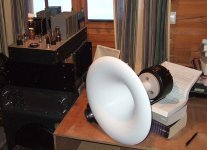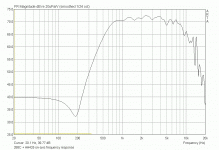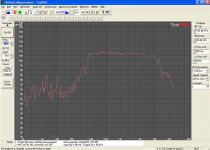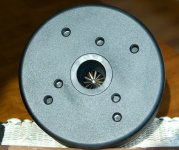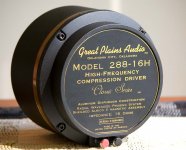Crikey! I hope not. At least not under domestic use.....and the compression driver never seeing more than 20 watts under any circumstances.
Well, considering the -12 to -15 dB attenuation (most of the power disappears in the shunt resistor), a lot less, even if the speaker is powered with a 60-watt amplifier. At any rate, the core is going to be a lot smaller than a 20-watt output transformer, more like something you'd see in a high-level 600-ohm line-driver transformer. No need for any shielding, either.
Resistors come in different designs. Besides the various material, the structure of the resistor is also critical to it's performance. Transformers/autoformer seem like a good alternative when it comes to large attenuation requirements.
They do tend to outperform caps/inductors/trannies by a rather large margin though
They do tend to outperform caps/inductors/trannies by a rather large margin though
Objectively, yes. Not that they're perfect, but the measured imperfections are down in the -150 dB range. Some resistors have doubtful construction quality; for example, when you cut apart some expensive metal-film resistors, the external copper leads are attached to the printed inner spiral by means of a press-fit cup, which invites the formation of a thin copper-oxide layer. Wirewounds, though, have the leads attached to the nichrome (or similar) resistance wire by welding, which excludes oxygen from the joint.
Back when I was fiddling around with these things with my Tek friends, and didn't find much to measure, no matter what we threw at them, the most likely conjecture was a subtle bimetallic distortion as a result of the P/N junction between dissimilar metals. Thermocouples, for example, rely on the well-defined thermal coefficient of the P/N junction between two dissimilar metals.
We arrived at a guess that much of the sound of a resistor was more of a function of the local P/N junction than the bulk resistance material - and part of the reason for the sonic neutrality of old-school carbon-comp resistors was the absence of a metallic P/N junction between the copper leads and the bulk carbon filler. But carbon-comps really do have measurable distortion, not to mention lots of noise.
But this is off-the-wall speculation, and would take very rigorous measurements to track down. I throw this in the general "why does this sound this way" category with capacitors, silver vs copper, and other audio arcana. Caps at least have measurable microphonics in the 1~5 kHz range, I've seen that for myself on a spectrum analyzer.
Last edited:
I do agree that may be the case, but I think the real reason is that they isolate some of the other problems occuring in the circuit. Generally, in circuit analysis, I doubt you can see the improvement; this tells me that the actual non-ideal parts are problematic, and in different application, use of transformers/autoformers reduce certain interaction allowing improved performance to be obvious. One think is the ground current flow. If you can localize ground current flow, you can get better performance control.They do tend to outperform caps/inductors/trannies by a rather large margin though
To recap, the crossover for the Altec/GPA299 Alnico 16-ohm & AH425 Azurahorn is as follows:
[700 Hz 4th-order highpass filter, transitional between Bessel and LR4, designed for 15~16 ohm load] -> [-12 to -14 dB attenuator, either L-pad or 16-ohm shunt preceding auto or transformer] -> [optional 2nd-order Bessel or LR2 lowpass in the 7~10 kHz range] -> [optional Zobel inductance compensator] -> [Large-format compression driver, 16 ohms]
Comments on optional portions: the 7~10 kHz 2nd-order lowpass is only useful if a supertweeter is used. Frequency selection depends on where you think the supertweeter should be crossed over; a 2nd to 3rd-order highpass filter is recommended for the supertweeter.
Used by itself, the Zobel compensator is very slightly audible as a little bit of extra sweetness at the top of the range. If the 7~10 kHz 2nd-order lowpass filter is used, the Zobel is strongly recommended.
This is not a "paper" crossover: it has been auditioned and measured in the prototype and has excellent subjective integration with the Altec/GPA 416B Alnico woofer (16-ohm version) and the RAAL Lazy Ribbon.
[700 Hz 4th-order highpass filter, transitional between Bessel and LR4, designed for 15~16 ohm load] -> [-12 to -14 dB attenuator, either L-pad or 16-ohm shunt preceding auto or transformer] -> [optional 2nd-order Bessel or LR2 lowpass in the 7~10 kHz range] -> [optional Zobel inductance compensator] -> [Large-format compression driver, 16 ohms]
Comments on optional portions: the 7~10 kHz 2nd-order lowpass is only useful if a supertweeter is used. Frequency selection depends on where you think the supertweeter should be crossed over; a 2nd to 3rd-order highpass filter is recommended for the supertweeter.
Used by itself, the Zobel compensator is very slightly audible as a little bit of extra sweetness at the top of the range. If the 7~10 kHz 2nd-order lowpass filter is used, the Zobel is strongly recommended.
This is not a "paper" crossover: it has been auditioned and measured in the prototype and has excellent subjective integration with the Altec/GPA 416B Alnico woofer (16-ohm version) and the RAAL Lazy Ribbon.
Last edited:
Back when I was fiddling around with these things with my Tek friends, and didn't find much to measure, no matter what we threw at them, the most likely conjecture was a subtle bimetallic distortion as a result of the P/N junction between dissimilar metals. Thermocouples, for example, rely on the well-defined thermal coefficient of the P/N junction between two dissimilar metals.
We arrived at a guess that much of the sound of a resistor was more of a function of the local P/N junction than the bulk resistance material - and part of the reason for the sonic neutrality of old-school carbon-comp resistors was the absence of a metallic P/N junction between the copper leads and the bulk carbon filler. But carbon-comps really do have measurable distortion, not to mention lots of noise.
But this is off-the-wall speculation, and would take very rigorous measurements to track down. I throw this in the general "why does this sound this way" category with capacitors, silver vs copper, and other audio arcana. Caps at least have measurable microphonics in the 1~5 kHz range, I've seen that for myself on a spectrum analyzer.
Lynn, minor point perhaps, but likening a metal to metal junction to a P/N junction is pretty far off the mark. Metals (conductors) have different work functions and any time two metals come together there is a potential barrier equal to the difference in the work functions. This causes some electrons to flow from one side of the junction to the other to establish equilibrium. If you think about this you realize that there are likely hundreds of such junctions in an audio signal path. Solder joints, junctions between copper wires and gold connectors, internal joints in capacitors and resistors, tube pins in sockets plated with some other metal compared to the pins, ... If anything it is more like an N/N junction between dissimilar, heavily doped semiconductors materials.
Anyway, I understand your point, the presents of a potential barrier, but it would seem unlikely that adding one more pair of dissimilar metal contacts in the signal path (the tweeter series resistor) would have a noticeable effect given all the other junctions in the signal path.
How many resistor junctions can fit on the head of a pin? Regards
Depends on the pin!
FWIW, carbon is actually classified as a semiconductor. So there will be some charge accumulation/depletion at a carbon/metal junction as well.
Hello,
IMHO the behaviour mentionned by Lynn for certain types of resistors can be increased largely when they are used in vibrations polluted environment... by example a passive crossover...
It is a bit the same as with Branly's coheror
Le Cohéreur de BRANLY
Branly's coheror is made of a simple glass envelop containing some iron powder and equipped with 2 opposite electrodes.
Submitted to vibration the iron dust conducts the signal.
It was used in the first time of Radio before the invention of the diode...
Best regards from Paris,
IMHO the behaviour mentionned by Lynn for certain types of resistors can be increased largely when they are used in vibrations polluted environment... by example a passive crossover...
It is a bit the same as with Branly's coheror
Le Cohéreur de BRANLY
Branly's coheror is made of a simple glass envelop containing some iron powder and equipped with 2 opposite electrodes.
Submitted to vibration the iron dust conducts the signal.
It was used in the first time of Radio before the invention of the diode...
Best regards from Paris,
Sorry looks like one of my images didn't take- shown is a clamshell isobaric system with approx 2L enclosed volume, so significantly stiffer than a 4L volume.
http://www.diyaudio.com/forums/multi-way/100392-beyond-ariel-158.html#post3143548
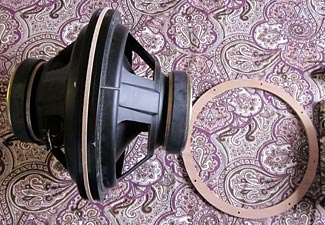
http://www.diyaudio.com/forums/multi-way/100392-beyond-ariel-158.html#post3143548

Lynn - No shelf on the horn? I usually by pass the series resistor with a cap to tilt the top end up. Or sometime other networks are needed to take out the midrange hump.
With some careful work and low passing at ~7K that was not needed on my rig. But without the super tweeter above 7K, it certainly was.
Of course you will not have a series resistor, but some shaping is usually needed, right?
With some careful work and low passing at ~7K that was not needed on my rig. But without the super tweeter above 7K, it certainly was.
Of course you will not have a series resistor, but some shaping is usually needed, right?
Lynn - No shelf on the horn? I usually by pass the series resistor with a cap to tilt the top end up. Or sometime other networks are needed to take out the midrange hump.
With some careful work and low passing at ~7K that was not needed on my rig. But without the super tweeter above 7K, it certainly was.
Of course you will not have a series resistor, but some shaping is usually needed, right?
Here are the first measurements of the AH425 and vintage Altec 288C, made by Bjorn Kolbrek the day he received them from Australia (note snow outside the window - Bjorn lives in Norway). Some of the small ripples are the result of where the horn is sitting; once the AH425 is mounted in free air - even 2 or 3 inches of separation from the bass cabinet gives a measurable and audible improvement.
The third picture is Martin Seddon's measurement of a Yamaha JA6681B compression driver on the AH425 at 1 meter. The Yamaha may have a slight mismatch of exit angle for the AH425, which is optimized for the 8-degree exit angle of the Altec/GPA 288.
The measurements of the Radian 745Neo are even flatter - more like a straight line up to about 12 kHz. The exit angle of the Radian 745Neo is 4 degrees, while the AH425 is 8 degrees, but a mismatch that small appears to be benign.
As far as I can tell, it doesn't look like in-band EQ is necessary, or desirable. They certainly sound flat, even on pink-noise. Listening to a large-format compression driver on a horn this flat is an unusual experience; you have the horn dynamics, but none of the FR in-your-face quality. For lack of a better description, it sounds like a big electrostat.
Attachments
Last edited:
Since the peaks and dips of the two measurements don't fall in the same places, I'm guessing they are the result of the compression driver itself and/or small measurement artifacts.
I don't have the data files of the AH425 & Radian 745Neo, but that was smoother than either of these graphs. The neodymium version of the Radian 745 is a very very good driver; I heard a rumor that Radian spent two years on the magnet and phase-plug design, and I can believe it, based on the flatness and the phenomenal efficiency (114~115 dB/meter).
The Great Plains Audio 288-16H Classic Series combines the radial phase plug with an Alnico magnet, a combination that was originally available from Altec for about a year before they switched to a ceramic magnet (while retaining the radial phase plug). Bjorn's 288C's (with Alnico magnets) use the traditional machined-aluminum circumferential phase plug, so I'd expect some differences in the frequency response between the two.
I have not measured the GPA 288-16H, but I expect it will also be very, very good, thanks to the Alnico magnet and the radial phase plug.
I don't have the data files of the AH425 & Radian 745Neo, but that was smoother than either of these graphs. The neodymium version of the Radian 745 is a very very good driver; I heard a rumor that Radian spent two years on the magnet and phase-plug design, and I can believe it, based on the flatness and the phenomenal efficiency (114~115 dB/meter).
The Great Plains Audio 288-16H Classic Series combines the radial phase plug with an Alnico magnet, a combination that was originally available from Altec for about a year before they switched to a ceramic magnet (while retaining the radial phase plug). Bjorn's 288C's (with Alnico magnets) use the traditional machined-aluminum circumferential phase plug, so I'd expect some differences in the frequency response between the two.
I have not measured the GPA 288-16H, but I expect it will also be very, very good, thanks to the Alnico magnet and the radial phase plug.
Attachments
Last edited:
- Home
- Loudspeakers
- Multi-Way
- Beyond the Ariel

